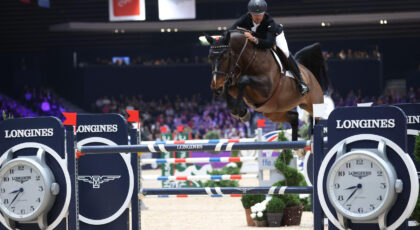Should a horse be barefoot or shod? What is the role of science and research in shoeing horses, both now and in the future?
Farrier Pat Reilly, Chief of Farrier Services and Director of the Applied Polymer Research Laboratory at the University of Pennsylvania, shares his insights on these topics and more in the second episode of the Sport Horse Podcast.
As Chief of Farrier Services, Reilly’s typical workday is anything but. “When you work in an a tertiary emergency practice, the unknown is the one thing you can count on,” said the recent Royal Veterinary College graduate. (Reilly earned a graduate diploma in Equine Locomotor Research.)
Tasked with coordinating with the medical team to help manage the lame horses that present to the Center, he sometimes sees as many as four laminitis cases in a day. Reilly discussed the role of teamwork in this setting and having open communication between all members of the staff to ensure the horse receives the best care possible.
It’s a theme that translates to horse care in general.
Take the barefoot versus shod debate. At the Tokyo Olympics, the Swedish jumping team made headlines following their success with barefoot horses. Since this time, there has been much discussion on whether more horses should be kept barefoot.
“There are really cool stories about human footwear and how human athletes, when they’re barefoot, use two percent less oxygen than their shod counterparts and the runners they are wearing. We don’t know why,” said Reilly.
“There may be beneficial aspects to not having shoes on [a horse]. But, to my knowledge, those are the first two horses that have performed at the Olympic level without shoes on and come home with medals. So, there’s still a lot [to learn].”
Reilly has personal experience with sport horses competing at a high level barefoot as well as shod. He shared key considerations that may influence whether a horse could (or should) be kept barefoot and provided rationale for why he went one route over the other for different horses.
He also shared some interesting concepts from a historical perspective. You can listen to a previous lecture he gave on the history of horseshoeing in the US here:
The takeaway: every horse is unique and has unique circumstances. This means that there aren’t general parameters for what types of horses are more likely to succeed shod versus shoeless. He stressed the importance of evaluating each horse individually with your vet, farrier, and trainer team in order to make the best shoeing decisions for that horse at that time.
Beyond Reilly’s strong grasp of current farrier practices, he is passionate about advancing hoof care knowledge and discovering new ways to approach thousand-year-old questions.
To this end, he uses small wearable devices placed on the horse’s body to measure how they move and, importantly, how different showing approaches and hoof management strategies can impact this movement. If you go to Pat Reilly’s YouTube channel, you can find some excellent videos demonstrating some of his work to date.

For example, Reilly developed an instrumented shoe that could be placed on a horse’s foot to measure force distribution under the hoof. In the videos, you can see how jumping, different gaits, and turning change forces under the hooves in real time.
He has also worked with the EquiGait system, which places small wearable devices on the horse’s body to provide precise information about limb push-off and symmetry. With these tools, Pat is able to better understand how different shoeing (or barefoot) strategies impact movement, and which approach may be most beneficial for each individual horse.

Listen to this episode of the Sport Horse Podcast with Pat Reilly! We are already planning to have him back in the future and are hoping to incorporate some of his great content into our learning library.
Find this episode and more at Sport Horse Podcast. Follow hosts Dr. Tim Worden and Nicole Lakin at www.ehpsg.com for more great science content.
Feature image: Trajectories for the left front (top) and right front (bottom) hooves while walking in one horse. This data was collected with the Werkman Black, which is a small wearable device affixed to the front of the hoof wall. You can see that the left front hoof has more vertical displacement during the first half of the swing phase while the right hoof has a flatter trajectory. This information can be valuable when understanding asymmetries in how a horse moves as well as optimizing a shoe type to change movement. Courtesy of Pat Reilly.
About the expert

Pat Reilly has been shoeing horses since graduating from the Midwest Farrier School in 1990, with a specialty in shoeing sport horses. In 2006, Pat joined the University of Pennsylvania serving as the Chief of Farrier Services and the Director of the Applied Polymer Research Laboratory. He recently graduated from the Royal Veterinary College with a graduate diploma in Equine Locomotor Research.




 March 2, 2022
March 2, 2022 




























